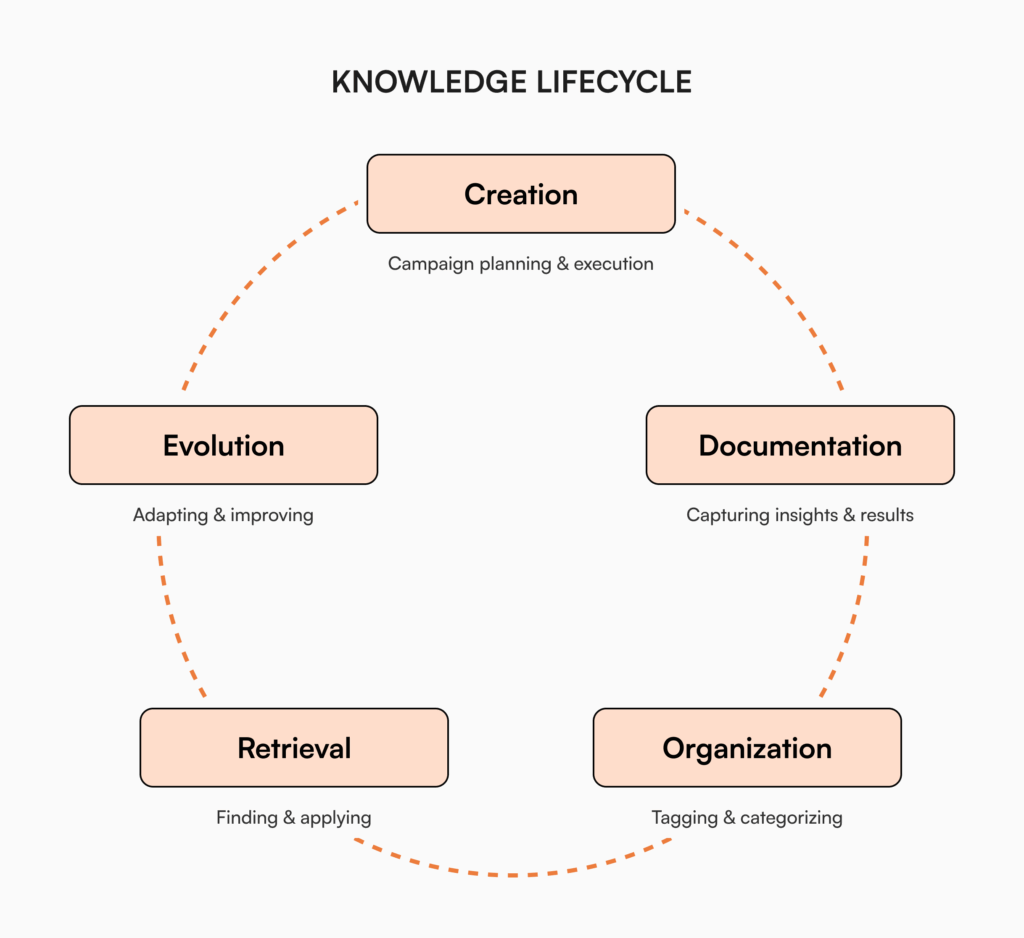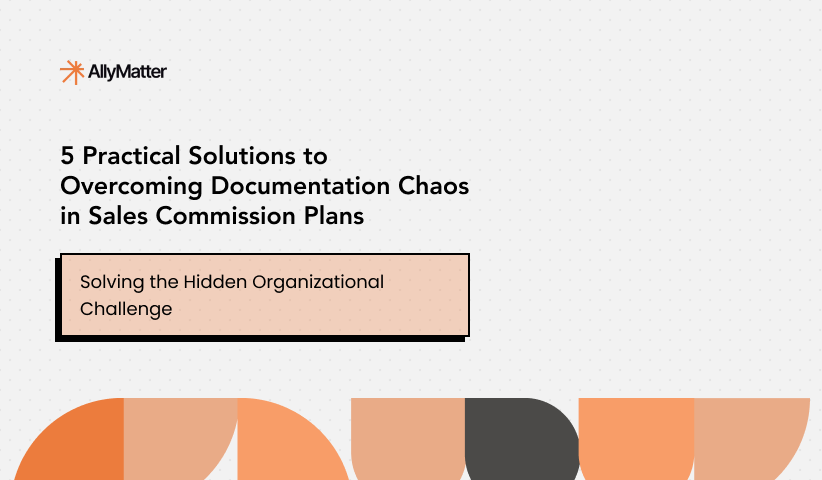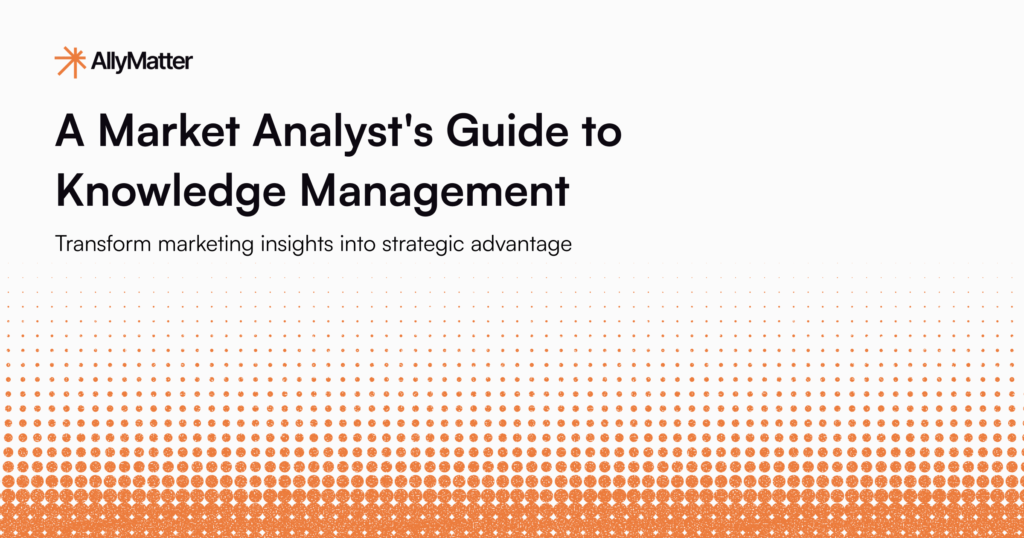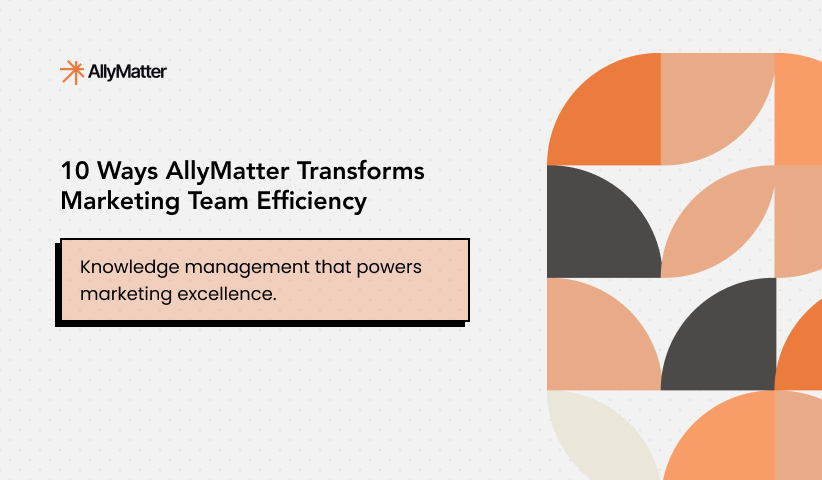“Where’s that campaign brief that performed so well last quarter? Who has the targeting parameters we used for that successful LinkedIn campaign? Didn’t someone already solve this exact problem last year?”
If these questions sound familiar, you’re experiencing what many marketing teams face daily: the costly impact of knowledge gaps. For lean marketing teams especially, these gaps aren’t just frustrating they’re holding your team back from its full potential.
When marketing team members change roles or leave your company, they take valuable knowledge with them. This ongoing challenge means teams are constantly losing institutional knowledge about what campaigns worked, why they succeeded, and how to replicate that success. Knowledge becomes siloed, creating inefficiencies that slow down your marketing efforts and force new team members to start from scratch rather than building on proven tactics.
The impact goes beyond mere inconvenience. Every departed team member takes valuable campaign insights, process knowledge, and customer understanding with them. For lean marketing teams, this knowledge loss is particularly damaging because you often don’t have redundancy built into your roles and processes.
What is a marketing knowledge base?
A Marketing Success Library is a structured knowledge base specifically dedicated to documenting successful marketing initiatives, campaigns, and processes. Unlike general documentation that simply describes what was done, an effective knowledge management system captures the strategic thinking, contextual factors, and measurable outcomes that made particular approaches successful.
This specialized repository transforms knowledge held by individual team members into organizational knowledge available to the entire team. The key difference between a standard marketing archive and a success library is its focus on capturing both the “what” and the “why” behind marketing success.

Essential components include:
- Campaign templates with comprehensive performance notes
- Creative briefs that drove exceptional results
- Documented marketing processes that streamlined workflows
- Testing methodologies and findings
- Channel-specific insights with performance metrics
- Customer engagement patterns that resonated
This isn’t just about preserving documents; it’s about preserving context, reasoning, and the critical thinking that drove marketing success.
What to document: A decision path for marketing teams
NNot everything needs documenting. Use this decision tree to determine what belongs in your ‘What Worked’ library:
Document this if:
- It produced exceptional results (significantly above benchmarks)
- Multiple team members will need this information in the future
- It represents a process innovation or efficiency gain
- It involved significant resources or institutional learning
- It captured unique customer insights
- It would be difficult to recreate without documentation
Skip documenting if:
- It follows standard processes already well-documented
- It produced average or below-average results
- It was a one-off campaign unlikely to be repeated
- The market conditions have fundamentally changed
For marketing teams, the highest-value documentation typically includes:
- Campaign architecture documents that outline the full structure of successful campaigns
- Creative approaches that resonated with specific audience segments
- Channel optimization strategies that delivered exceptional ROI
- Messaging frameworks that drove engagement and conversion
- Marketing process documentation for complex marketing technology setups
Creating access that works: Organization strategies
A ‘What Worked’ library is only valuable if people can find what they need when they need it. To achieve this, focus on three critical organizational elements:
Effective Tagging Systems
Develop a consistent tagging taxonomy that reflects how your team thinks about marketing activities:
- Campaign Type: awareness, lead generation, conversion, retention
- Channel: social, email, content, paid search, events
- Audience Segment: decision-makers, influencers, specific industries
- Content Format: video, blog, whitepaper, webinar
- Performance Level: exceptional, above average, average, below average
- Campaign Stage: planning, creative, execution, measurement
Ensure everyone uses the same tagging conventions to maintain consistency.
Searchability considerations
The same principle that makes your website search functionality crucial for customers applies to your internal knowledge systems; powerful search is essential.
Ensure your ‘What worked’ library has:
- Full-text search capabilities
- Tag-based filtering
- Metadata searching (by date, author, etc.)
- Customizable views based on different team roles
Role-Based Access Design
Not everyone needs the same level of access to all marketing information. Create appropriate permission levels:
- Viewers: Can access and search documentation but not edit
- Contributors: Can add documentation using established templates
- Editors: Can revise existing documentation and templates
- Administrators: Can manage the entire system and user permissions
Implementation without overwhelm
Building a comprehensive marketing knowledge base might seem daunting, but with a phased approach, even lean marketing teams can create valuable knowledge resources without disrupting daily operations.
Before vs. after: The knowledge capture transformation
Before: Marketing Manager Sarah creates a brilliant campaign that exceeds targets by 40%. The campaign brief lives in her email, the creative assets are spread across three different drives, and the targeting parameters exist only in her marketing platform login. When Sarah gets promoted to another department three months later, the campaign’s success can’t be replicated because the knowledge leaves with her.
After: Sarah completes a standardized document within a week of the campaign’s completion. The document includes links to all assets, platform settings, and performance data all stored in the centralized knowledge base with appropriate tags. Six months later, when Sarah has moved to another role, the new campaign manager can easily find, understand, and adapt the successful approach for a similar audience.
Practical starting points
Begin with these manageable steps:
- Start with your greatest hits: Document your 3-5 most successful recent campaigns first
- Create simple templates: Begin with basic documentation templates that capture essential information
- Schedule regular contribution time: Block 30 minutes weekly for knowledge capture
- Assign clear ownership: Designate a team member to champion the initiative
- Celebrate early wins: Recognize when documented knowledge helps solve problems
Measuring your knowledge base’s impact
How do you know if your ‘What Worked’ library is actually delivering value? Track these key metrics:
Efficiency metrics
- Time saved searching for information (surveys can help quantify this)
- Reduction in duplicate work or “reinventing the wheel”
- Faster campaign planning and execution timelines
Team adoption indicators
- Number of team members actively contributing
- Frequency of access and searches
- Variety of content being documented
Business impact measurements
- Improved campaign performance from applying documented learnings
- Faster onboarding for new team members
- Reduction in knowledge loss during team transitions
Your marketing team’s effectiveness depends on applying lessons learned from past campaigns. A well-structured knowledge base ensures those lessons aren’t lost when team members change roles or leave the organization.
Teams with effective knowledge sharing capabilities typically see improvements in campaign performance and project completion rates. Your marketing success library should directly contribute to similar improvements in marketing outcomes.
Why AllyMatter for your marketing ‘What worked’ library
AllyMatter transforms how marketing teams preserve their institutional knowledge. Unlike typical file storage systems that just save documents, AllyMatter’s smart tagging capabilities organize your successful campaigns by channel, audience segment, and performance metrics so your team can quickly find what worked in similar situations.
The platform’s intuitive search functionality means marketers can instantly locate specific campaign elements like targeting parameters or creative approaches that previously generated results. With granular access controls, you can ensure everyone from new team members to agency partners sees exactly what they need while protecting sensitive information.
As marketing tactics evolve, the version tracking system maintains a clear history of how your successful approaches have adapted over time. For lean marketing teams especially, AllyMatter eliminates the frustration of recreating campaigns from scratch when team members change roles, turning your past marketing wins into a foundation for future success.
Unlike general-purpose documentation tools, AllyMatter was built to ensure critical knowledge remains accessible and usable, even as team members come and go.
Moving forward with marketing knowledge management
Creating a marketing ‘What Worked’ library isn’t just about preserving documents; it’s about capturing the strategic thinking and contextual insights that drive marketing success. By implementing a structured approach to knowledge management, lean marketing teams can:
- Prevent the costly loss of institutional marketing knowledge.
- Accelerate campaign planning and execution.
- Enable consistent performance even through team transitions.
- Build upon past successes rather than starting from scratch.
- Onboard new team members more effectively.
The most successful marketing teams don’t just create campaigns; they create systems that ensure their best work can be understood, replicated, and improved upon over time.
Ready to build a marketing knowledge base that preserves your team’s best work? Talk to our experts to discover how AllyMatter can help your marketing team create a comprehensive marketing documentation that drives consistent results.
Frequently asked questions
How long does it take to build a marketing success library?
Building a comprehensive library takes time, but you can start seeing benefits within weeks. Begin with documenting your 3-5 most successful recent campaigns, and gradually build from there. Most teams find they can create a valuable knowledge base within 2-3 months of consistent effort.
Who should be responsible for maintaining the knowledge base?
While everyone on the team should contribute, designate a knowledge base champion who ensures consistency, encourages contributions, and maintains the system. This role works best when rotated periodically to prevent knowledge silos from forming around the curator.
How do we ensure team members actually use the library?
Integrate the knowledge base into your regular workflows. Reference it during campaign planning meetings, make it part of your campaign post-mortem process, and celebrate when documented knowledge leads to successful outcomes. Teams adopt tools that visibly improve their work lives.
What if our marketing strategies change significantly?
A well-designed ‘What worked’ library should include context about market conditions and audience circumstances. Even as strategies evolve, understanding why certain approaches worked in specific contexts remains valuable. Regular reviews can help identify when documentation needs updating or archiving.
How detailed should our documentation be?
Focus on capturing enough detail that someone unfamiliar with the campaign could understand not just what was done, but why decisions were made and what outcomes resulted. Include links to assets and platforms rather than trying to document everything in a single file.


